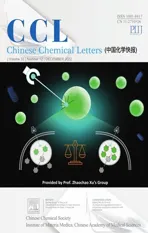Recent progress on two-dimensional materials confining single atoms for CO2 photoreduction
2023-01-30XianjinShiLeoCaoMeijuanChenYuHuang
Xianjin Shi ,Leo N.Y.Cao ,Meijuan Chen,Yu Huang
a Key Laboratory of Aerosol Chemistry and Physics,State Key Laboratory of Loess and Quaternary Geology(SKLLQG),Institute of Earth Environment,Chinese Academy of Sciences,Xi’an 710061,China
b Center of Excellence in Quaternary Science and Global Change,Chinese Academy of Sciences,Xi’an 710061,China
c University of Chinese Academy of Sciences,Beijing 100 049,China
d CAS Center for Excellence in Nanoscience,Beijing Key Laboratory of Micro-nano Energy and Sensor,Beijing Institute of Nanoenergy and Nanosystems,Chinese Academy of Sciences,Beijing 101400,China
e School of Nanoscience and Technology,University of Chinese Academy of Sciences,Beijing 10 0049,China
f School of Human Settlements and Civil Engineering,Xi’an Jiaotong University,Xi’an 710049,China
Keywords:CO2 reduction Photocatalyst Single atom 2D materials g-C3N4
ABSTRACT Photoreduction of CO2 into value-added products offers a promising approach to overcome both climate change and energy crisis.However,low conversion efficiency,poor product selectivity,and unclear mechanism limit the further advancement of CO2 photoreduction.The development of two-dimensional(2D)materials and construction of single atom sites are two frontier research fields in catalysis.Combining the advantages of 2D materials and single atom sites is expected to make a breakthrough in CO2 photoreduction.In this review,we summarized the design and application,proposed challenges and opportunities,and laid a foundation for further research and application of 2D materials confining single atoms(SACs@2D)for CO2 photoreduction.
1.Introduction
In recent years,achieving carbon neutrality has attracted extensive attention in the media,politics,and science[1–3].As a major greenhouse gas,the effective control of CO2emissions is critical to realizing carbon neutrality.If effective strategies to reduce CO2emissions are not taken,the steadily increasing concentration of carbon dioxide in the atmosphere will continue to increase the global average temperature,causing a series of natural disasters and extreme weather[3].However,the increasing hunger for energy by an ever-growing human population is unceasing and there is no doubt that CO2emissions will not stagnate[4].
In nature,CO2can be converted into organic matter by plant photosynthesis,providing an effective way to solve the contradiction between the increase of energy consumption and the reduction of CO2emissions[5–10].However,from a thermodynamic point of view,the reduction of CO2to CO,methane(CH4),methanol(CH3OH),formic acid(CHOOH),or other C2 productions are very unfavorable due to the high bond energy of C=O(750 kJ/mol)[11].These processes,like the widely studied photocatalytic hydrogen evolution reaction(HER)and nitrogen reduction reaction(NRR)[12–14],require a certain amount of energy.Therefore,it is necessary to develop and use abundant"green"energy to catalyze the conversion of carbon dioxide.Being widely studied,photocatalysis using clean solar energy is one of the most effective methods to catalyze the recovery of CO2resources[15,16].However,for photoreduction of CO2to value-add products,high criteria for photocatalyst design is required:(1)efficient conversion process,(2)good product selectivity,and(3)high stability[17].As such,the design of photocatalyst is the key factor to achieving CO2reutilizationviaphotocatalysis[18].
With high design criteria,single-atom catalysts(SACs)are the appropriate candidates for CO2reduction[19–21].SACs have many advantages[22]:(1)unexpectedly high activity and selectivity due to its unsaturated coordination and tunable electronic structures;(2)the maximum atom utilization efficiency,resulting in the reduced cost,especially for precious metals;(3)well-defined active sites for mechanistic studies because they can bridge the gap between heterogeneous and homogeneous catalysis.Due to the unique advantages,numerous SACs were synthesized and studied in photocatalysis CO2reduction in recent years[18,23].
The general catalytic performance of SACs is determined by the selection of carrier materials because when the particle size is reduced to a single atom,the isolated atoms should be anchored on carrier materials that prevent aggregation due to an increase in surface free energy[18,24,25].Therefore,to this end,supports in various carrier materials have been developed for anchoring single atoms,such as metal-containing materials(e.g.,TiO2[26],FeOx[27],Mo2S[28])and metal-free materials(e.g.,graphene oxide[29],carbon nitride[30]).
Among the numerous carrier materials,two-dimensional(2D)materials are attractive candidates,which is the thickness of only one or a few atomic layers[11,15,31].The unique physical and chemical structure of 2D material allows a higher density of single atoms.In addition,compared to block materials,2D materials can create more unsaturated coordination centers,have unique electronic structures,and contain higher catalytic activity generally[32–34].
Combining the above-mentioned advantages of 2D materials and single atom sites,2D materials confining single atoms(SACs@2D)have the following features[33,35,36]:(1)a large specific surface area to increase the metal single atom load and achieve 100%active sites exposure;(2)the energy band structure of 2D materials can be effectively adjusted by single atoms,and thus effectively improve the visible light response and photocatalytic CO2reduction performance;(3)the unsaturated coordination structure of SACs@2D benefits the adsorption and activation of CO2,facilitating higher photocatalytic CO2reduction;(4)SACs@2D can be easily analyzed by advanced characterization techniques,providing convenience for theoretical research.Studies have shown that the single atomic sites on 2D materials are excellent CO2reduction sites[37–41].Therefore,SACs@2D for CO2photoreduction is worthy of further study.
Although many reviews have summarized the synthesis,characterization,and application of 2D materials confining single atoms[31,33,42–44],a comprehensive overview of SACs@2D for the CO2photoreduction is missing,especially how single atoms are supported on 2D materials and the functions of single atoms sites for CO2reduction process.Therefore,in this review,the design of SACs@2D is first summarized,providing practical guidance for the design and synthesis of SACs@2D.Secondly,SACs@2D for photocatalytic CO2reduction is reviewed to provide a comprehensive understanding of the functions of single atomic sites.Finally,the major challenges and opportunities for further research and application of SACs@2D for CO2photoreduction are proposed.Thus,the research status and trends of SACs@2D in CO2photoreduction are fully understood,laying a foundation for the further application of SACs@2D for CO2photoreduction.
2.Single atoms supported on 2D nanomaterials
The key point of SACs synthesis is to anchor isolated atoms on the 2D carrier materials surface properly,because the prerequisite for the practical application of SACs is that the single atoms do not aggregate during the catalytic process,that is,the single atoms locate at the desired location without any significant migration[45].However,preventing the aggregation of single atoms during preparation and catalysis is a great challenge[46].Fortunately,there are many great significant progresses for 2D materials that support single atoms,providing theoretical guidance for the rational development of SACs@2D future.Taking typical 2D material g-C3N4as an example[5,47–50],there are three main kinds of positions for anchoring single atoms:The pore structure,interlayer structure between two layers,and defect sites,as shown in Fig.1.This section will review the suitable sites of 2D materials for confining single atoms.
2.1.Single atoms confined into pore structure
The intrinsic pore structure of some materials is a candidate to confine single atoms.For example,g-C3N4is composed of tri-striazine rings,based on sp2hybridization ofπconjugated graphite planes by alternating C and N connections[51–53].The internal pore structure filled with six N atoms with lone-pair electrons is an ideal site for anchoring atoms to prevent them from aggregating.
In addition to the coordination on the original atoms of the pore structure,the heteroatoms on pore structure of 2D materials are also useful sites to support the single atom.For example,being widely studied,N heteroatom coordination metal single atoms(M-Nx)catalysts have shown their excellent catalytic activity for several catalytic reactions[54,55].In addition to N atoms,O or P atoms are also alternative coordination heteroatoms.For example,Gaoet al.reported single Co sites coordinated on the partially oxidized graphene nanosheetsviaa Co-O3C configuration[22].Moreover,Chuet al.also synthesized the sing Co atoms by coordinating Co above the void center of g-C3N4by heteroatom P[56].The strong ligand-metal coordination between single metal atoms and heteroatoms of 2D materials is beneficial for facile manipulation of loading sites.
One advantage of confining of single atom into the internal pore structure of 2D materials is to improve the light absorption capacity of 2D materials.For example,Xionget al.synthesized a series of g-C3N4inclusion Pt single atoms photocatalysts,in which Pt single atoms are confined to the“N pots”[57].By incorporating a trace amount of Pt single atoms in the“N pots”of g-C3N4,the light absorption of g-C3N4can be broadened to 900 nm by the metal-toligand charge transfer(MLCT).The MLCT mechanism also applies to non-noble metal Cu single atom confined in the internal pore structure.In addition to Pt and Cu atoms being confined to the internal pore structure,Fe and Zn atoms can also be incorporated into the g-C3N4matrix,and it is found that the band gap of g-C3N4becomes narrower with the introduction of Fe atoms[58].
In addition to light absorption properties,charge transfer properties can also be adjusted by introducing single atoms into the pore structure[59].For example,Liet al.embedded isolated single Pt atoms on the top of the five-membered rings of g-C3N4network[60].The dispersion of single Pt atoms on g-C3N4modulated the electronic structure and introduced the intrinsic change of the surface trap states,resulting in a nearly twofold decrease in average recovery lifetime of photon-generated carriers,suggesting that Pt single atoms provide more opportunities for photogenerated electrons to participate in photocatalytic reactions.The charge transfer channel can be constructed by placing the single atoms into the internal pore structure of g-C3N4,and the utilization rate of light can be improved.

Fig.1.Potential sites of single atom supported on g-C3N4:(a)pore structure;(b)interlayer space;(c)defect sites.Color codes:carbon is brown,oxygen is red,and a confined single atom is green.
Another advantage of confining single atom in the internal pore structure is to optimize the electronic structure and modify energy band levels.For example,M−N/C configurations can optimize the electronic structure and modify the band energy levels,because the electrons tend to transfer from the metal-sites to the N atomsviathe strong interaction,resulting in the downshift of the valence band maximum(VBM)level.Inspired by the above phenomena,Suet al.modified the valence band structure of g-C3N4by introducing Pt single atomsviaa“high-valence metal single-atom confinement”strategy[61].The hybridization of Pt 5d and N 2p downward shifts the VBM level of modified g-C3N4by 0.26 V relative to bare g-C3N4,triggering a highly efficient photocatalytic water oxidation process.
Taken together,reasonably confined single atoms in the internal pore structure of 2D materials has the following functions:optimizing light absorption performance,improving charge transfer performance,adjusting band position,and providing the active sites for CO2photoreduction.
2.2.Single atoms confined in layer structure
The interlayer structure is also a candidate position for confining single atoms,because 2D materials are usually stacked together by weak van der Waals forces,which may prevent metal atoms from clustering[62].Inspired by this,Caoet al.atomically dispersed Pd single atoms in both bridged sites of adjacent layers and surface-sites of g-C3N4to accelerate charge separation[63].Theoretical prediction and experiment characterizations reveal that single Pd atoms in bridged sites of adjacent layers provide directional charge-transfer channels.Such a unique structure efficiently boosts electron transport and separation.In addition to single Pd atoms,Cu single atoms can also be confined in the interlayer structure of g-C3N4[64].For example,Xiaoet al.anchored Cu single atoms between g-C3N4planes by intercalation of chlorophyll sodium copper(C34H31CuN4Na3O6,CSC)into a supramolecular precursor.The single Cu atoms in two neighboring layers established Cu-N4charge transfer channels,which significantly improve the interlayer transfer of photogenerated charge carriers.
In addition to being confined in interlayers of the same material,single atoms can also be confined in the interfaces between 2D material and other semiconductor materials.For example,Zhaoet al.prepared a series of composite photocatalysts by confining rare earth elements(Lu,Yb,Tm,Er,Ho,Dy,Gd,Eu,Nd,Pr,and La)single atoms onto the interface between g-C3N4and CdS[65].In these photocatalysts,CdS:Dy3+/g-C3N4is the best photocatalyst for CO2reduction.Further DFT calculation results show that single Dy atoms are suitable for electron transfer in the CdS/g-C3N4due to the intermediate excited state energy level of Dy3+located between the conduction bands of g-C3N4and CdS.In addition,this strategy is also suitable for the synthesis of SrTiO3:Er3+/g-C3N4composite catalysts[66].The surface single Er atoms on SrTiO3facilitate the construction of charge transport channels between SrTiO3and g-C3N4,resulting in enhanced interfacial charge transfer and separation.
In general,the introduction of single atoms can enhance charge transfer in 2D material layers or interface between 2D material and other materials.
2.3.Single atoms confined into vacancy defects
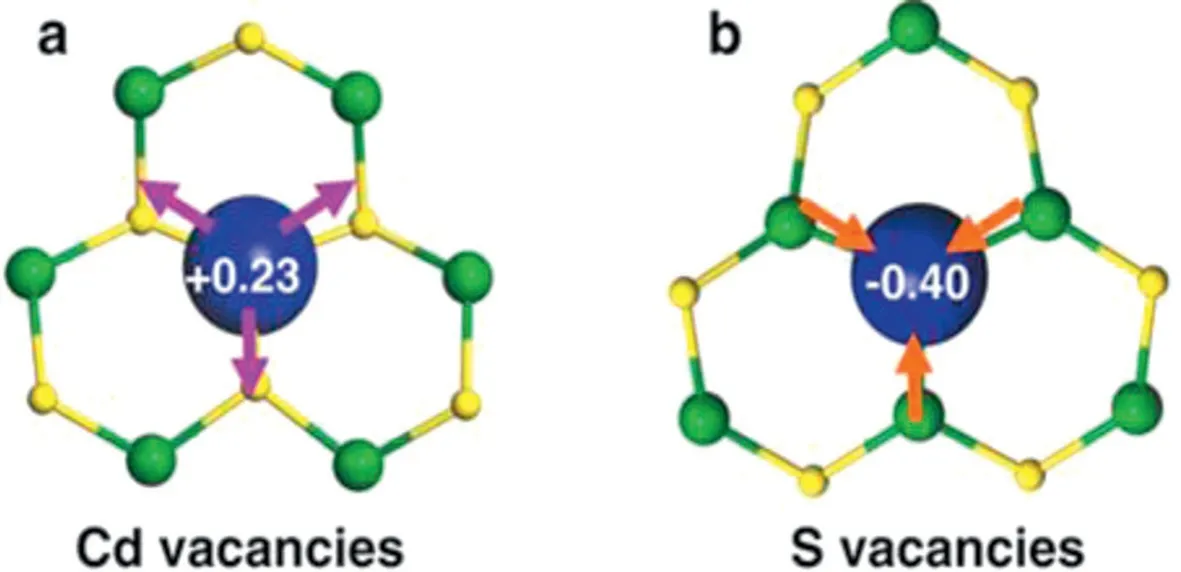
Fig.2.Electron transfer between Au and CdS with different types of vacancies:(a)Cd vacancies;(b)S vacancies.Reprinted with permission[67].Copyright 2021,Springer Nature.
Confined single atoms in defect sites,widely used in the synthesis of SACs,is also suitable for the synthesis of SACs@2D.For Example,Caoet al.designed and fabricated a series of single Au atoms supported on CdS with different types of vacancies(Fig.2)[67].For the sample of Au single atom supported on CdS with Cd vacancies(Cd1−xS),the Cd vacancy electron paramagnetic resonance(EPR)signals decreased obviously after supporting single Au atoms,indicating that single Au atoms coverer part of Cd vacancies.Similarly,the authors also synthesized Au single-atom supported on CdS with S vacancies(CdS1-x)samples.Interestingly,the types of vacancies for anchoring Au single atom highly affect the electron transfer direction.
A single atom will not only be confined in defects sites,it may also induce the formation of defective structures around it.For example,Zhanget al.found that single Ru atoms supported on MoS2induce phase transition of MoS2and generation of S vacancies,which efficiently tailors the electronic structure of MoS2[68].
In conclusion,single atoms supported on vacancy defects of 2D materials mainly play roles in regulating the band structure and providing the active site of 2D materials.
3.Photoreduction of CO2 by SACs@2D
Upon identifying the design of SACs@2D,we are now in a position to decode the function of single atoms for CO2photoreduction.Generally,it is widely accepted that the photocatalytic CO2reactions are triggered by the photogenerated electrons on the surface of a semiconductor.For a SAC@2D catalysts,electrons in valence band of carrier material are excited into its conduction band when the photon energy is equivalent to or higher than its band gap energy.The excited electrons are transferred to the single atom sites to drive the CO2photoreduction reaction[69].However,photocatalytic CO2reduction is a multiple proton-coupled electron transfer process with many intermediates,so the different numbers of transferred electrons and protons will form different reduction products.In addition,reduction potential determines whether the reaction can take place,which has strict requirements on the conduction band position of SACs@2D.Furthermore,for the multicarbon products,the difficulty of C–C coupling is another limiting factor.Up to now,the main products of photocatalytic CO2reduction are C1 products,including CO,CH4,CH3OH,and HCOOH,and only a few reported products were C2 or C2+products.[11].Therefore,the function of SACs@2D for photocatalytic CO2reduction will be reviewed in this section,and the typical applications of SACs@2D for photocatalytic CO2reduction are listed in Table 1[22,35,67,70–81].
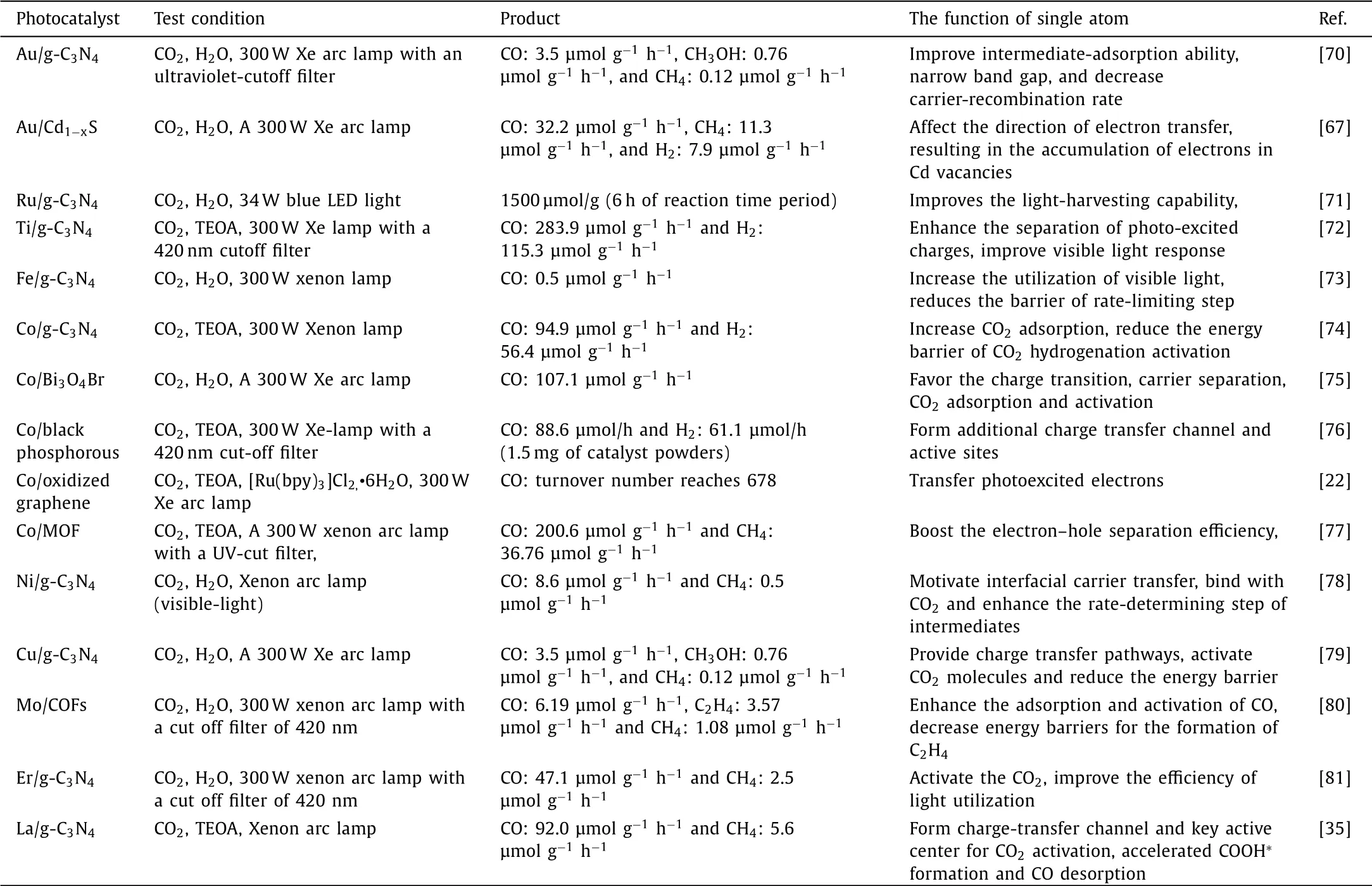
Table 1 Summary of various SAC@2D toward CO2 reduction.
3.1.Noble metals-based SACs@2D
Due to the advantages of excellent catalytic activity and stability,the function of single sites in noble metals-based SACs@2D is worth studying[27,82–85].Therefore,this part mainly introduces the functions of single noble metal sites in CO2reduction.
The noble metals-based single sites determine the selectivity of the CO2photoreduction products.For example,Gaoet al.investigated Pd/g-C3N4and Pt/g-C3N4for photoreduction of CO2by DFT calculations[86].They found that the desorption of HCOOH from the Pd/g-C3N4catalyst possesses the largest barrier on the entire reaction pathway(0.46 eV),while the desorption energy from the Pt/g-C3N4catalyst is 1.06 eV,suggesting that the formation of HCOOH is unfavorable on the Pt/g-C3N4catalyst.Similarly,Zhouet al.studied the noble metal(Rh,Pd,Ag,Ir,Pt,and Au)single atom supported on defective g-C3N4for CO2photoreduction by DFT calculations[87].They found that the noble metal single atom tends to be trapped at the N-vacancy sites of g-C3N4rather than the surface internal pore structure.The N-vacancy-stabilized Pd single atom on g-C3N4show the lowest energy barrier for HCOOH production.
In addition to affecting the selectivity of the product,noble metals-based single sites on SAC@2D can also improve the activity of the product.For example,as shown in Fig.2,Caoet al.proposed a different mechanism for surface electron density modulation using single Au atoms supported CdS[67].When electrons concentrate on vacancies rather than single Au atoms,the adsorption type of CO2changed from physical adsorption to chemical adsorption.The reason for this phenomenon is that the strong hybridization of Au 5d and S 2p orbits accelerates the photo-electrons transfer onto the surface.Therefore,lots of photoelectrons are transferred to the surface to participate in CO2reduction reaction and finally achieve efficient carbon dioxide reduction.Moreover,Xianget al.synthesized Au single atoms on amino group-enriched graphitic carbon nitride through a mild urea reduction method[70].For this catalyst,the CO and CH4yields over this Au single atom photocatalyst are 21.7 and 2.4μmol/g after 2.5 h of visible-light illumination,which are about 1.97 and 4.15 times those of pure g-C3N4.This improved photocatalytic performance is ascribed to the improved intermediate-adsorption ability,narrowed band gap,and decreased carrier-recombination rate after the introduction of Au single atom.Note that the introduced amino group improves its CO2affinity and helps improve CO2reduction.In addition,Sharmaet al.achieved efficient photocatalytic CO2reduction to CH3OH by single Ru atoms supported on porous g-C3N4catalysts with a high yield of 1500μmol/g(6 h under visible light)[71].Ru-N/C coordination structure can accelerate charge transfer and increase charge density of active sites,thus realizing the enhanced photocatalytic activity of Ru single atom modified g-C3N4for the aqueous photoreduction of CO2to CH3OH using water as the sacrificial agent.
To sum up,although the researches of noble metals-based SACs@2D for CO2photoreduction have made some progress in improving product yield and selectivity,many problems still need to be addressed.For Example,the application of noble metalsbased SACs@2D catalysts in photocatalytic reduction of CO2is rarely reported with experimental validation but has been widely studied with other reactions,such as hydrogen production(Pt[57,60,88,89],Pd[90,91],Ag[59],and Rh[92]),NO oxidation(Pt[93,94]and Pd[95]),and acetylene hydrogenation(Pd[96]and Au[97]).The main reason why noble metals-based SACs@2D catalysts are rarely used in the photoreduction of CO2reaction in experiments is the competitive reaction of H2generation[98].The H2production not only affects the utilization effi-ciency of photogenerated electrons but also limits the yield and selectivity of products such as CH4.Therefore,in order to realize the application of noble metals-based SACs@2D catalysts in CO2reduction reactions,the active sites must be reasonably modified.
3.2.Transition metal-based SACs@2D
When catalyst prices are considered,the substitution of cheap transition metals for noble metals is worth studying.Therefore,the function of transition metal single atom in SACs@2D for photoreduction CO2is summarized in this part.
The transition metal single atom with variable redox states is an excellent CO2photoreduction site.For example,Wanget al.synthesized Cu modified g-C3N4by C-Cu-N2coordination structureviasupramolecular preorganization with subsequent condensation[79].In this photocatalyst,the variable-valence C-Cu-N2sites can provide effective charge transfer pathways reduce the energy barrier toward photocatalytic CO2reduction,as shown in Eqs.1–7:
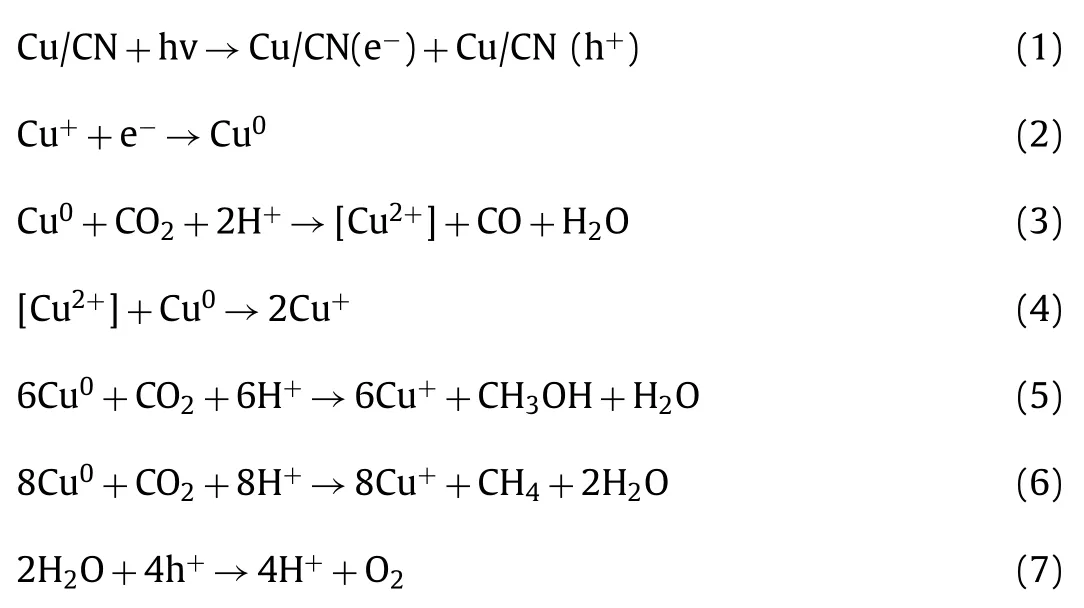
Note that the mechanism mentioned above has a certain universality[99,100].For example,Tanget al.demonstrated that single Ti-O species supported on g-C3N4can convert CO2into CO by photoreduction[72].The Ti4+can be transformed to Ti3+by the light-generated electrons under the visible light irradiation.Then,the reduced Ti3+changes back to Ti4+by one electron transfer to co-catalysts(Co(bpy)32+)to convert CO2into CO.
Among the various function of transition metal single sites,CO2adsorption capacity is one of the most important functions.For example,Chenget al.reported an unsaturated edge confinement strategy,that is,single Ni sites coordinated on the few layer g-C3N4viaa self-limiting method[78].The obtained sample achieves a comparably high performance of CO2photoreduction to CO under visible light illumination(8.6μmol g−1h−1),which is 7.8 times that of the unmodified few-layer g-C3N4.In this process,further mechanism studies showed that the introduction of unsaturated Ni-N coordination is beneficial to improving CO2adsorption capacity and facilitating photogenerated electrons transfer,thereby achieving the comparably high photocatalytic activity for converting CO2to CO.Moreover,Gonget al.synthesized g-C3N4supported Co(Fe and Mn)single atom by one-step thermal treatment of Co-MOF(Fe-MOF and Mn-MOF)and urea in the air[101].The obtained sample exhibits excellent performance for photocatalytic reduction of CO2to CO with a high CO evolution rate of 394.4 μmol g−1h−1under visible light irradiation with hole sacrificial agent(TEOA),which is over 80 times higher than that of unmodified g-C3N4(4.9μmol g−1h−1).Experiment results show that the main reasons for the great improved CO evolution rate are the improved CO2absorption ability and charge separation efficiency after the introduction of single Co atoms.
In addition to charge transfer and CO2adsorption,the transition metal single sites also greatly affect the activation of CO2.For example,Liet al.prepared Cu single atoms supported on crystalline g-C3N4nanorods catalyst by molten salts and reflux method[102].For this catalyst,photoreduction of CO2-to-CO is a favorable reaction than CO2-to-CH4over single Cu sits,thus achieving the enhanced photocatalytic CO2reduction with near 100%selective CO2photoreduction to CO.In addition,Kouet al.introduced single MoN2sites into COF to construct Mo-COF materials and found that this active site can reduce CO2to C2product(C2H4)[80].Further experiments and calculations show that the formation of C2is due to the reduction of the energy barrier for the formation of C2H4by the introduction of Mo single atom.
In general,transition metal sites have multiple functions simultaneously.For example,Zhaoet al.reported a single Fe atom supported on g-C3N4catalyst for the CO2photoreduction with water as the sacrificial agent[73].For this catalyst,experiment and DFT calculations results reveals that the function of single Fe atoms as follow:(1)activating CO2in the ground state;(2)increasing the rate constant of the limiting step;(3)providing the catalytic active center;(4)lowering the reaction barrier of the C–O bond cleavage in COOH.In other words,the above-mentioned advantages of single Fe atoms together improve the performance of photocatalytic reduction of CO2.
In all,great progress has been made in developing the function of transition metal-based SACs@2D,but the role of some elements remains to be further studied.For example,some common single transition metal sites,such as Mn[103]and Zn[104],have been proved to be good choices for CO2reduction,but their support in 2D materials needs to be further studied.
3.3.Rare earth metal-based SACs@2D
Rare earth metal-based SACs@2D for CO2photoreduction is also worthy of study,and the reasons are listed below[105].Firstly,the rare-earth elements are considered critical materials because of their optical,magnetic properties,and unique electronics,which are widely used in catalysis.Secondly,when rare earth metals are reduced to a single atomic scale,maximum utilization of metal elements can be achieved.In addition,atomic-scale rare-earth metals may have properties not found in their nanoscale homologues.Therefore,in this part,the function of rare earth metal single atom in SACs@2D for photoreduction CO2is reviewed.
The main function of single rare earth metal sites is to construct charge transport channels.For example,Chenet al.designed and synthesized single La atoms modified g-C3N4with La-N chargetransfer bridge[35].The La-modified g-C3N4realized a high rate(92μmol g−1h−1)and CO selectivity(80.3%)in photocatalytic CO2reduction.The experimental and DFT calculations results show that the variety of electronic states induced by 4f and 5d orbitals of the rare-earth La single atom and the p-d orbital hybridization of La-N atoms forms a charge transport channel,which is the key active sites for CO2activation.
Another function of the single rare earth element atom in SACs@2D is to build active sites for CO2photoreduction.For example,Jiet al.synthesized rare-earth element single atoms(Er)supported on g-C3N4by a novel atom-confinement and coordination strategy[81].With the increase of the amount of Er precursor,the dispersion density of single atoms can be tuned from the formation of a low-density Er single-atom catalyst with an Er mass loading of 2.5 wt%to a high-density Er single-atom catalyst with an Er mass loading of 20.1 wt%.In these two catalysts,the high-density Er single-atom catalyst shows higher catalytic performance,indicating that the active sites on the catalyst surface were effectively increased.
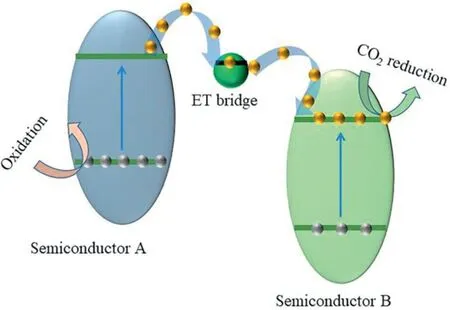
Fig.3.The proposed mechanism for single rare-earth element atoms as ET bridges to promote charge separation.
In another case,single rare earth metal atoms in SACs@2D have dual functions at the same time.For example,the dual functions of CO2molecular activation and charge transfer bridge for rareearth element single atom systematically studied by Wang’s groups[65,66,106].Taking the Dy3+single atom doped in the interface of CdS/g-C3N4heterojunction as an example,this structure combines the characteristics of rare-earth element single atom and the advantages of heterojunction[65].In this photocatalyst,Dy3+single atom is supported on the surface of CdS,so it also exists at the interface between CdS and g-C3N4.On the one hand,the intermediate excited state energy level of Dy3+in the interface of CdS/g-C3N4heterojunction can act as an electron transport bridge.On the other hand,the surface Dy3+single atom changes the density of active sites,which can promote the absorption of CO2.Under the dual functions of Dy single atom,the optimal catalyst realized an efficient photocatalytic reduction of CO2to CH4.Guided by the same idea,this group synthesized dual functions Er single atom in Zn2GeO4/g-C3N4heterojunction[106]and SrTiO3/g-C3N4heterojunction[66],and these rare-earth element single atom modified catalyst all achieved higher catalytic performance than that of pure g-C3N4.In such rare-earth element single atom supported on g-C3N4-based heterojunction(Fig.3),the position of the 4f levels of rare earth elements as electron transport(ET)bridge is very closely related to the conduction band position of the heterojunction materials.
Over all,both theoretical and experimental studies on the loading of rare-earth elements on 2D materials for the photoreduction of CO2are still in the initial stage,which needs to be further studied to show the advantages of rare earth elements.
4.Conclusions and outlook
In summary,this review summarizes the design and functions of single atomic sites for CO2photoreduction of SACs@2D in recent years.The suitable sites of 2D materials for confining single atoms are internal pore structure,interlayer structure or interface,and vacancy defects or heteroatoms.Moreover,the functions of welldesigned single atomic sites in CO2photoreduction includes enhanced light absorption,accelerated charge transfer,and improved adsorption and activation of CO2.
Although the studies on SACs@2D for CO2photoreduction have achieved significant progress,a few research directions still deserve special attention:
(1)At present,the activity of photoreaction CO2over SACs@2D is still at a relatively low level compared to electrocatalysis and thermal catalysis,especially with water as the sacrificial agent.Therefore,the conversion rate of the product needs to be further improved.Similarly,how to improve product selectivity remains an important topic.
(2)The stability of the single atoms sites needs to be further studied,because single atoms tend to agglomerate into clusters or particles during synthesis and application process.In addition,the presence of other pollutants may also occupy the active site,leading to the loss of catalytic performance of SACs.
(3)The single atom active site on catalyst surface is a dynamic change process during CO2reduction,so morein-situcharacterization should be conducted to study the changes of the single atom’s physicochemical properties during CO2reduction.At present,most conclusions are based on DFT calculation results,so spectroscopic characterization or electron microscopy characterization is needed to give more intuitive evidence.
(4)At the present stage,most of the products of CO2photoreduction are C1 products.Some effective approaches can be taken into consideration to solve the above problems,such as introducing dual single-atom active sites and other reactive groups around the single atom sites,and enhancing the interaction between single atoms and their carrier interface.
Declaration of competing interest
The authors declare that they have no known competing financial interests or personal relationships that could have appeared to influence the work reported in this paper.
Acknowledgments
This work was supported by the Strategic Priority Research Program of the Chinese Academy of Sciences,China (Nos.XDA23010300 and XDA23010000),National Science Foundation of China,China(Nos.51878644 and 41573138),the National Key Research and Development Program of China,China(No.2016YFA0203000),and the Plan for“National Youth Talents”of the Organization Department of the Central Committee.
杂志排行
Chinese Chemical Letters的其它文章
- Diverse strategic approaches en route to Taxol total synthesis
- Recent advances in gold-complex and chiral organocatalyst cooperative catalysis for asymmetric alkyne functionalization
- Unmodified methodologies in target discovery for small molecule drugs:A rising star
- Recent advances in single-crystalline two-dimensional polymers:Synthesis,characterization and challenges
- Environmental applications of graphene oxide composite membranes
- Recent advances in the application of metal organic frameworks using in advanced oxidation progresses for pollutants degradation
